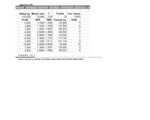Straddle8
Junior member
- Messages
- 30
- Likes
- 0
I've got a question regarding optimal f* and the Terminal Wealth Relative. I understand how to calculate both values but I'm a bit confused on the concept of TWR. Is this the multiplicator by which you multiplicate your:
a) starting equity ?
b) worst case scenario (maximum DD)?
For example, I have a starting equity of $100.000 and I make 10 trades with $-10.000 as worst case scenario. I use the table in Thomas Stridsman his book "Trading Systems That Work" on page 276.
In this table I end up with a TWR of 1,0965. Does this mean I made 1,0965 times my initial equity or 1,0965 times my worst drawdown? The author in the book multiplies this by the equity, but I'm not sure if this is the right method to apply optimal f*.
a) starting equity ?
b) worst case scenario (maximum DD)?
For example, I have a starting equity of $100.000 and I make 10 trades with $-10.000 as worst case scenario. I use the table in Thomas Stridsman his book "Trading Systems That Work" on page 276.
In this table I end up with a TWR of 1,0965. Does this mean I made 1,0965 times my initial equity or 1,0965 times my worst drawdown? The author in the book multiplies this by the equity, but I'm not sure if this is the right method to apply optimal f*.

